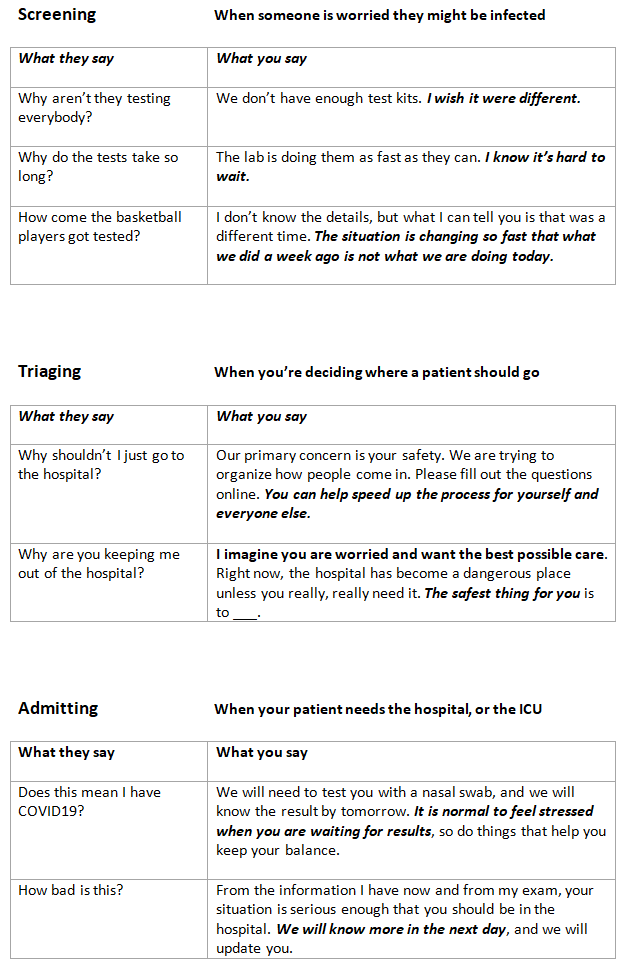COVID19: Kommunikasjonstips fra VITAL TALK
(Oversatt og modifisert til norsk av Ingrid Miljeteig, Kaya Cetin, BCEPS, og Nina E. Hjorth.)
Dette er en konsentrert samling av tips fokusert på COVID19, utviklet av Tony Back med flere ved University of Washington, Seattle, hvor det har vært mange dødsfall så langt i pandemien. Tony Back har blant annet gitt ut boken «Breaking bad news» og er internasjonalt kjent for sin praktiske tilnærming til å håndtere krevende kommunikasjon. Hvis du vil vite mer, sjekk ut «snakke-kartene» og videoene på vitaltalk.org. Du kan også laste ned en App: «Vital Talks». Vi har forkortet den opprinnelige versjonen av hans notat og forsøkt å tilpasse til norsk setting.
Når pandemien utvikler seg, vil antall smittede og syke avgjøre hvilket trinn i pandemiplanen som sykehuset følger: Trinn 1, trinn 2 og trinn 3. De fleste tipsene her er for trinn 1 og 2. Hvis vi går over i en krisestandard, vil medisinsk praksis kunne endre seg dramatisk, og tipsene må tilpasses. Husk at selv når man er i en krise kan vi fremdeles føle med og respektere hver person.
Noen av kommunikasjonstipsene i dette dokumentet skildrer måter å forklare ressursfordeling til en pasient eller familie eller omsorgsperson. Merk imidlertid at beslutninger om hvordan ressursene blir fordelt — hvilke kriterier som brukes eller hvor linjer trekkes - skal skje på et annet nivå — på avdelings, sykehus eller nasjonalt nivå. I disse tipsene styrer vi bort fra komplekse diskusjoner om prioritering, og bruker språk som er for lekfolk.
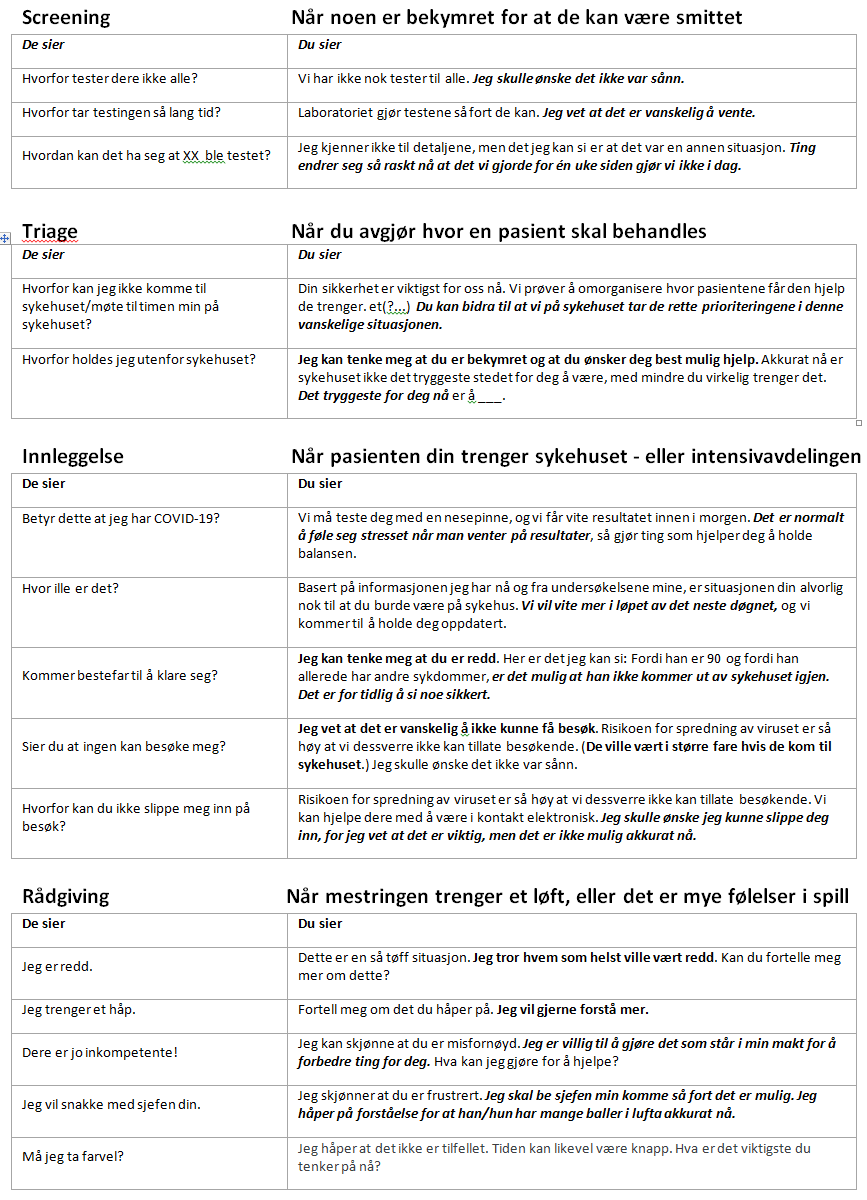
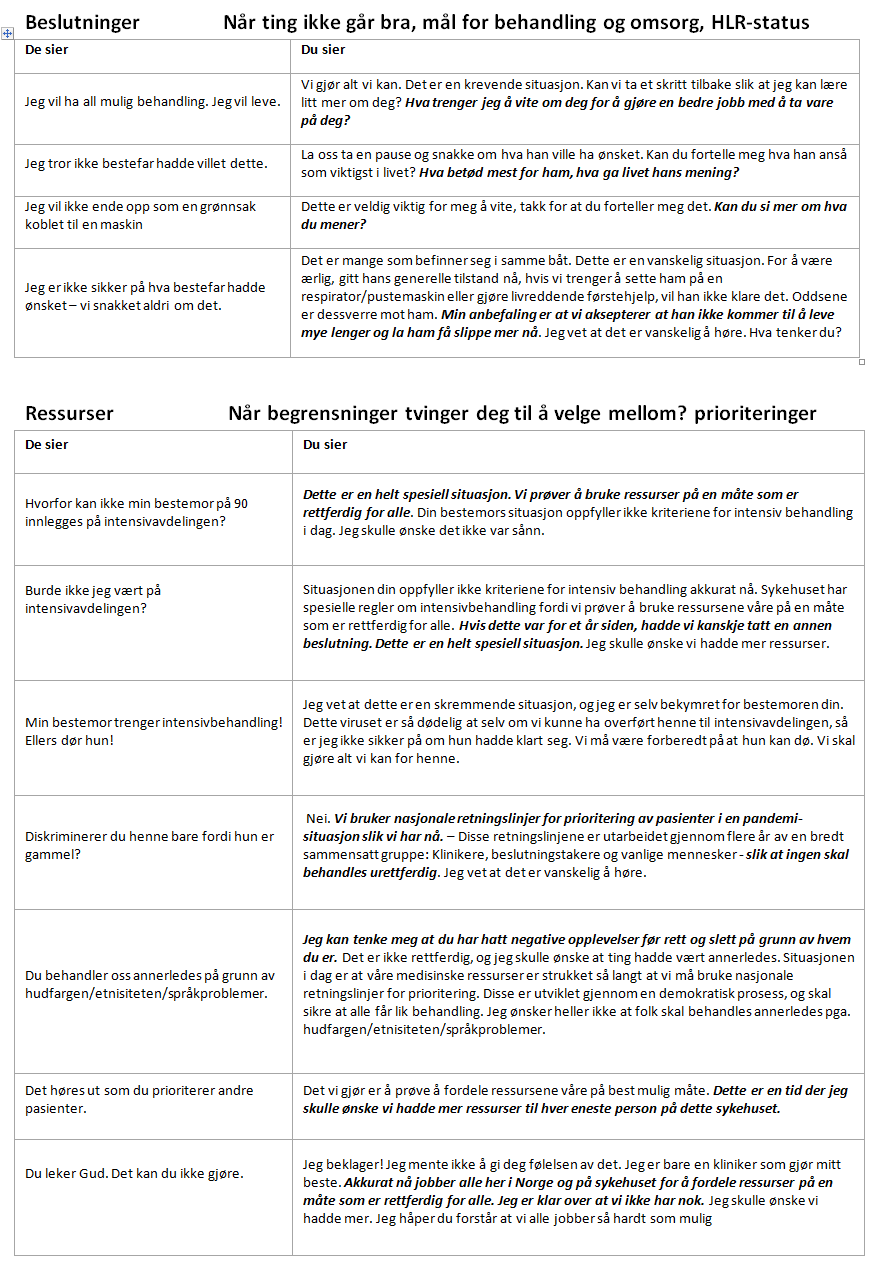
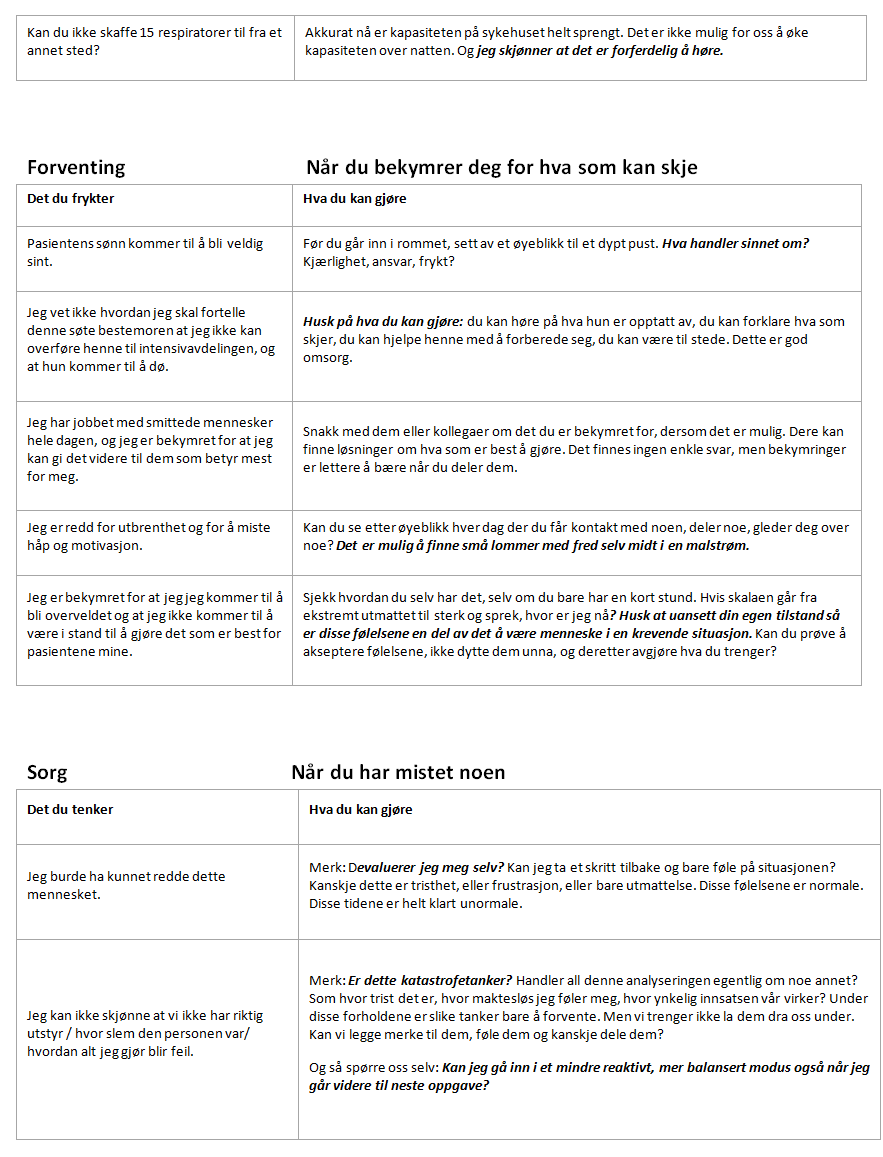
COVID-ready communication skills: A playbook of VitalTalk Tips
Updated 18 March 2020
Who?
To health care professionals everywhere: these are unprecedented times. There’s no roadmap. We’re facing conversations that we never expected—or wanted—to have.
Why?
In Seattle, it’s real. We’ve had patients die, and not all were elderly. One of our colleagues is intubated. All over the country we are all getting calls and concerns about how to handle the possible surge. We’re realizing that our professional duty might pose a risk to the people at home that we love. Worse, what we’re seeing now might be the trickle that becomes a tsunami. Like what’s happening in Italy. Hard to ignore. Not something you can leave at work.
But there is another side to this too. Our colleagues are pitching in. People are stepping up to support each other in unexpected, beautiful ways. Together we can be bigger. And we can make it through this with our empathy, compassion, and sense of service intact.
What?
In that spirit, we’ve crowdsourced this little primer to provide some practical advice on how to talk about some difficult topics related to COVID-19. Building on our experience studying and teaching communication for 2 decades, we’ve drawn on our networks to crowdsource the challenges and match them with advice from some of the best clinicians we know. If you know our work, you’ll recognize some familiar themes and also find new material. It’s incomplete and imperfect. But it’s a start.
How?
We’re offering this primer freely. Email it, link it, spread it around. Don't hesitate to change the links so it works for your particular clinic or institution or system. Then help us improve it. Tell us what we missed, what didn’t work, where you got stuck. The next iteration could be better because of you.
Stay safe.
Our world needs you—your expertise, your kindness, your aspirations, and your strength. We’re grateful you are here.
About VitalTalk
VitalTalk is a 501c3 nonprofit social impact startup dedicated to making communication skills for serious illness part of every clinician’s toolbox. This content will be in our free VitalTalk Tips app for iOS and Android very soon.
Using these tips
This is a super-concentrated blast of tips focused on COVID. We’ve pared away all the usual educational stuff because we know you’re busy. If you want more, check out the talking maps and videos on fundamental communication skills, family conferences, and goals of care at vitaltalk.org.
As the pandemic evolves, the caseload in your region will determine whether your clinic or hospital or institution is ‘conventional’ mode (usual care), ‘contingency mode’ (resources stretched although care functionally close to usual), or ‘crisis’ mode (demand outstrips resources). Most of the tips here are for conventional or contingency mode. If your region moves to crisis standards, how medicine is practiced will change dramatically—triage decisions will be stark and choices will be limited. If needed, future versions of this doc will shift towards crisis. For now, please note that the crisis mode tips should be reserved for a crisis. And remember that even in a crisis, we can still provide compassion and respect for every person.
Some of the communication tips in this document depict ways to explain resource allocation to a patient or family or caregiver. However, note that decisions about how resources are allocated—what criteria are used or where lines are drawn—should happen at a different level—at the regional or state or country level. Rationing should not occur at the bedside. In these tips, we steer away from complex discussions about rationing, and use language that is for laypeople rather than ethicists.
You can pitch in
Show this to the people you work with. Volunteer to edit so we can incorporate feedback in real time. Translate this into another language. Don’t just spread worries about how bad things will get—be the change you want to see. You can get in touch with us at tonyback@uw.edu or info@vitaltalk.org. https://www.vitaltalk.org/guides/covid-19-communication-skills/
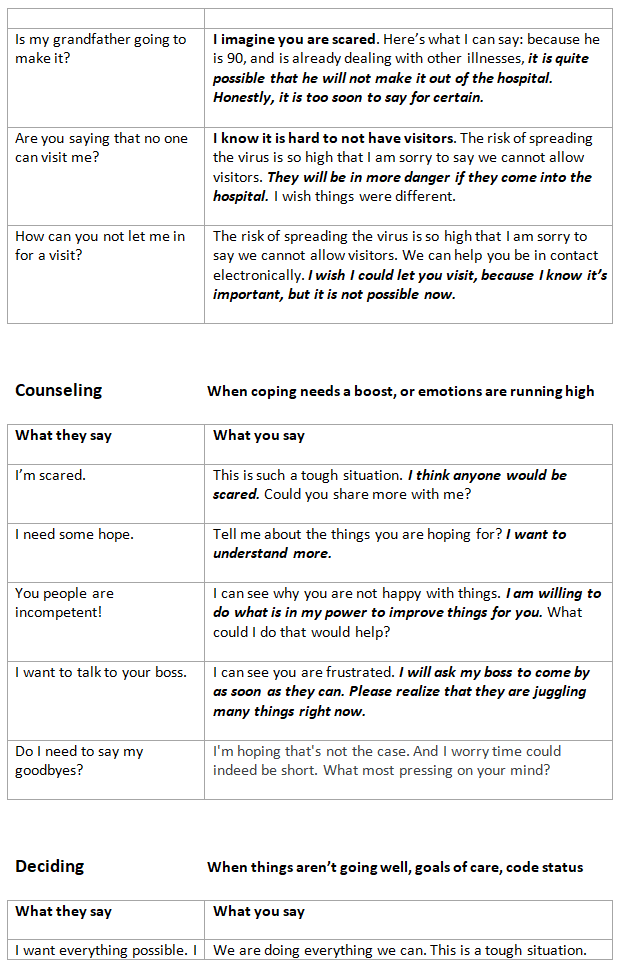
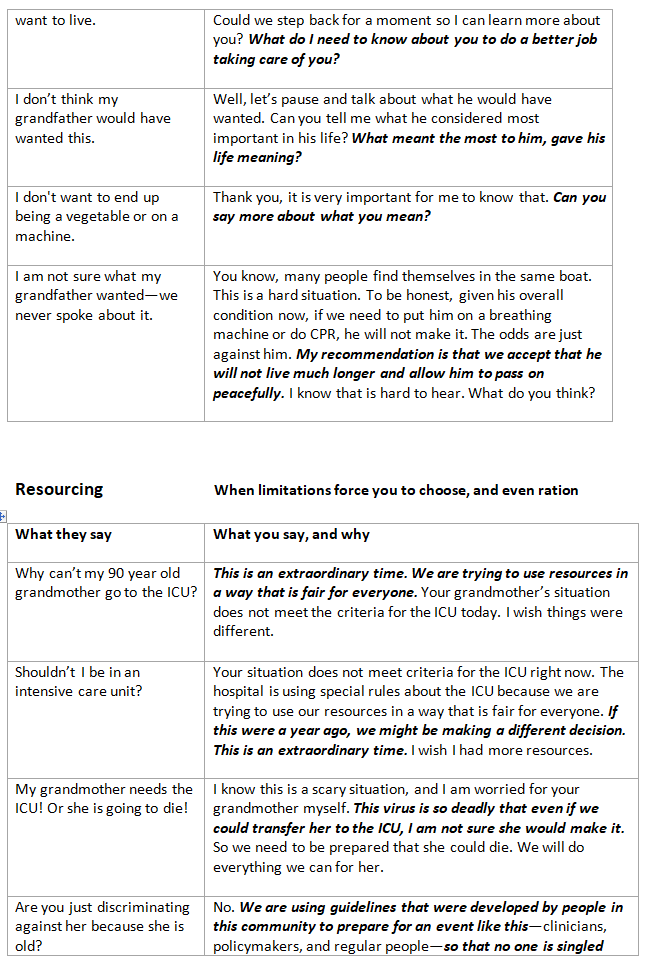
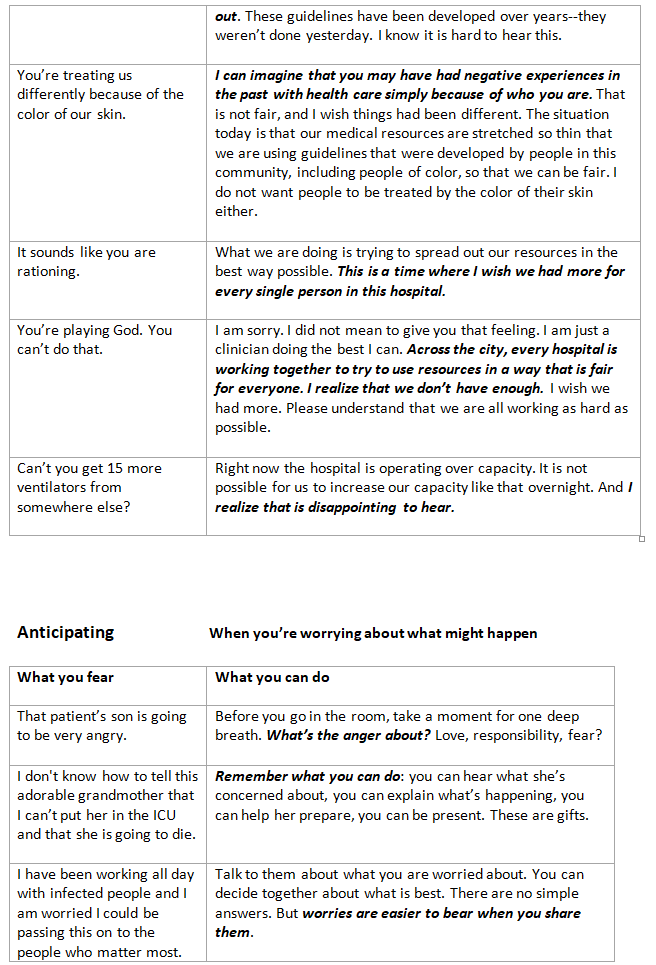
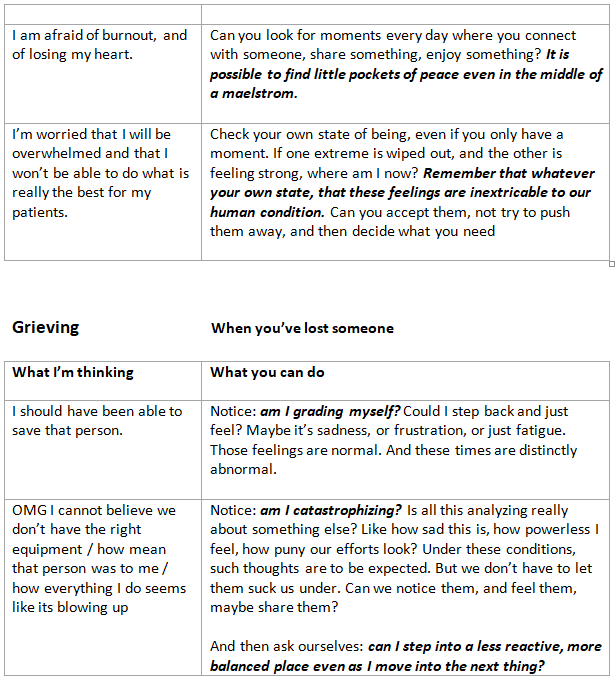
Your comments and feedback
Thank you all for contributing edits and ideas--they are extremely valuable, and we have incorporated most of them. If I did not incorporate your suggestion and you are wondering, you can email me at tonyback@uw.edu. Please note that this guide is designed as a completely-stand-alone-guide for clinicians, and thus some recommendations are slightly different than what we would teach in the context of an in-person or live virtual course.
Thank you
Bob Arnold MD
Randy Curtis MD MPH
Jonathan Fischer MD
Michael Fratkin MD
Margaret Isaac MD
Josh Lakin MD
Nick Mark MD
Susan Merel MD
Tona McGuire PhD
James Tulsky MD
Vicki Sakata MD
The John A. Hartford Foundation
Cambia Health Foundation

